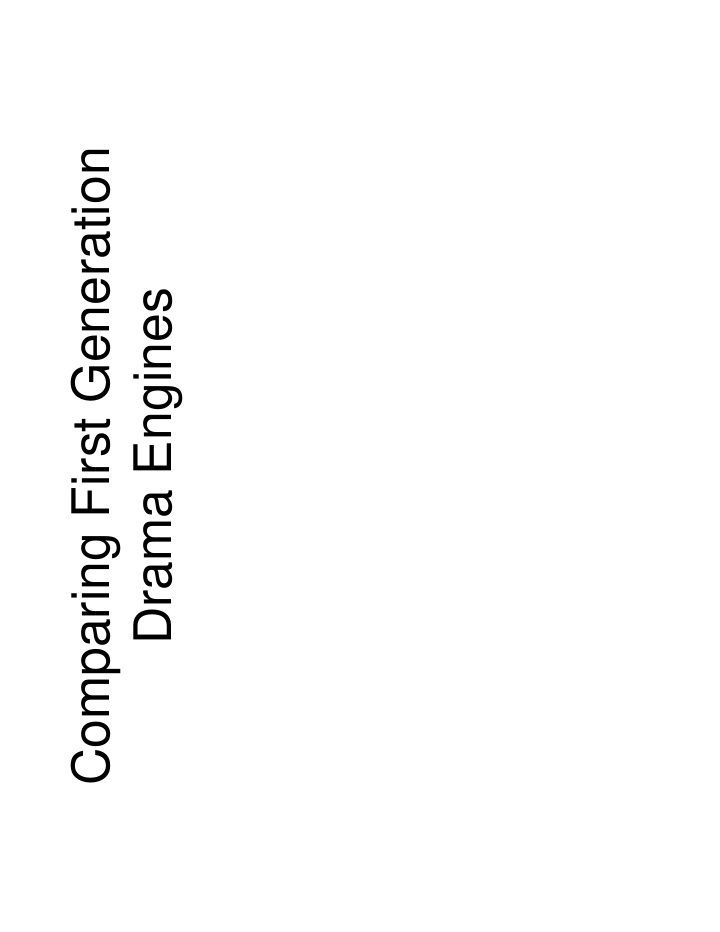



Comparing First Generation Drama Engines
What is a “Drama Engine”? • An engine capable of interpreting domain language code to support interaction with dramatically interesting characters • A way to creatively author character AI • A system that supports the self- organization of social contexts in the player’s mind, reflected to some degree in the game • The artistic and commercial future of play
Approaches To A Wicked Problem Engine Homogenous Heterogeneous Designs Characters Characters Generative Storytron Façade’s Architecture System Emergent Drama Princess Rocket Heart System
Storytron • World is composed of sentences in toy language, together they “generate” a story • Linguistic “Deikto” Interface – Turn-Based • Business model based on subscriptions • No animation, no spatial relationships • Static facial feedback • Special actor “Fate” manages discourse • Characters are defined by bounded (-1,1) floats, traits are constant, perception of traits is variable
Reacting To Verbs Involves Adjusting Variables
Every Way Of Reacting To A Given Verb Is Weighed By Inclination Equations The Author Designs, a Character’s Personality Traits are Taken as Input
Jane Rejects Fred’s Advances, Violence and Gossip Result
I Want To Get In Jane’s Head, So I Open Her Up In The Editor
After Adjusting Her Opinion Of Fred Things Go Better
Storytron Limitations • Each verb requires a minimum of five scripts per Boolean role, plus one script per variable adjusted and three or five scripts per reaction option • Content demands tend toward limited Local Agency, but powerful Global Agency due to generative recombination • Balancing and debugging potentially staggering due to highly coupled nature of content • Graphically spare front-end limits feedback
Façade’s Architecture • A suite of modules and languages • A high-level “Beat” authoring language • A language for global “Mix-in” behaviors • A language for local “Joint Dialogue” behaviors • A language parser build on top of JESS • A Drama Manager that uses probability at a high level to sequence “Beats”
A Behavioral Language: Core Content Creation Tool
Relative Proximity And Facial Expressions Give Feedback On Joint Dialogue Behaviors
Façade’s Architecture's Limitations • Learning curve for ABL is steep, authoring environment may improve this • Content is oriented toward rich Local Agency but limited Global Agency, more Beats may balance this by increasing number of generative recombinations • Input and feedback are not always clear, due to limitations of language parsing and system ambiguity • Actors attempts to play off out-of-character inputs rely on a complaint player
Drama Princess • Behavior and Animation Module for 144, a retelling of Little Red Riding Hood • Actors are “empty shells” driven by objects in environment and characterized by a single variable, enthusiasm , which weighs changes in affection for objects • Lack of feedback intentional to emphasize player interpretation • Filters on available behaviors (distance, condition, intimacy, affection) limit actions to a particular context • Uses probability at a low level to mix behaviors
Affection Rises
Adjusting Enthusiasm
Relationships Evolve Over Time
Limitations of Drama Princess • Oriented toward free-form play, can’t support goals or strategy • Randomness implies a lack of control, which implies a short-live novelty and little re-play value, though casual players may enjoy it occasionally to relax • Lack of behavioral complexity and language implies shallow social play • Little to no Global Agency
Rocket Heart • Characters behave in procedurally unique ways and have unique relationships in a goal context • Designed to nest inside more traditional forms of gameplay and interface with game engine • Game actions can alter code for character’s relationship actions • Actions are conducted in context of relationship, but can mismatch to dramatic effect • Hinges on carefully arranged, cascading feedback, based on periodic shifts in relationships and reacting actions • Tactile interface provides context-sensitive options
An Argument Between Rivals
Anna: A Shy Romantic
Rocket Heart Limitations • Requires supporting gameplay for involving play complexity • Characters tend toward over-the-top behavior, limiting potential aesthetics to Shogo-sequel theatrics, and potential audiences to the casual web and mobile spaces • Balancing behaviors with game context and other actors is difficult • Tends toward more Local than Global Agency, more strongly than Facade
Conclusions On The Outset Of The First Generation • Emergent systems are much faster to create than Generative systems (five months versus five years) • Procedurally unique characters richen Local Agency, while balancing and content limits constrain Global Agency, visa versa for homogenous, data-differentiated characters • Generative systems can provide social play that stands on its own, while emergent systems are augmentative to more traditional forms of play • Once a system has been established and tested, the time involved in producing content becomes much lower than spatial level design in traditional games • Procedural and/or modular art assets make drama game development significantly cheaper than lineated games
What Would Entail A Second Generation Drama Engine? • Clearly and thematically designed input schemes that are “consistently inconsistent” – matching feedback that can be inferred from character cues to a degree of ambiguity that is balanced with the game • Leveraging of available forms of social feedback (language, gestures, relative proximity, facial expressions, posture) in a complementary suite • Leveraging new forms of input to make context-sensitive verb choices more intuitive and less mechanical (e.g. Wii and PS3 motion sensors) • Successful experimentation with background social simulation to cue characters based on a greater culture, or to allow the player to influence said culture indirectly (candidates include Boid’s algorithm, Memetic algorithm’s driven by authored heuristics)
Recommend
More recommend